Hydroplaning can be a nerve-wracking experience for any driver. It’s that heart-pounding moment when your vehicle loses traction and skids across a wet road, leaving you feeling helpless. But what exactly is hydroplaning, and why does it happen?
Let’s delve into the details of hydroplaning, why it happens, what to do if your car hydroplanes, and most importantly, how to prevent it.

Why Your Car Hydroplanes?
Hydroplaning occurs when a layer of water forms between your vehicle’s tires and the road surface. When this happens, your tires lose contact with the road, leading to a loss of control and potential accidents.
Several factors contribute to the risk of hydroplaning, including:
Tire Tread Depth
Worn-out tires with shallow tread patterns are more susceptible to hydroplaning. Insufficient tread depth reduces your tires’ ability to disperse water, making them more likely to ride on top of it.
Speed
Driving too fast in wet conditions increases the risk of hydroplaning. Higher speeds make it difficult for your tires to channel water away effectively, increasing the chance of losing traction.
Water Depth
The depth of water on the road plays a significant role in hydroplaning. Even a small amount of water, especially when combined with other factors, can lead to hydroplaning.
Tire Pressure
Underinflated tires have a larger contact patch with the road, increasing the likelihood of hydroplaning. Maintaining proper tire pressure is crucial for safe driving.
What to Do When Your Car Hydroplanes
Experiencing hydroplaning can be frightening, but understanding how to react is pivotal for ensuring your safety and that of fellow road users. Here’s a guide on what to do when your car hydroplanes:
Remain Calm & Stay Focus
In the midst of a hydroplaning event, panic can be a natural response. However, maintaining a composed demeanor is vital. Take a deep breath and concentrate on regaining control of your vehicle.
Refrain from Abrupt Braking
One of the most common errors during hydroplaning is slamming on the brakes, which can exacerbate the situation, causing your vehicle to skid further out of control. Instead, gently release the accelerator to slow down gradually, allowing your tires to regain traction.
Steer Gently
Maintain a firm grip on the steering wheel and steer in the direction you intend to go. Make subtle and controlled movements, avoiding sudden, sharp turns that can lead to a further loss of control.
Gradually Regain Traction
As you follow the steps mentioned earlier, you might start to sense your tires regaining traction on the road. When this happens, gently accelerate to steady your vehicle. It’s crucial to be patient and avoid sudden or rapid acceleration. Wait until you’re confident that you have full control before increasing your speed.
Check Your Surrounding
While regaining control of your vehicle, be aware of your surroundings. Ensure that you are not at risk of colliding with other vehicles, obstacles, or the road’s edge.

How to Prevent Hydroplaning?
Preventing hydroplaning is essential for maintaining safe driving conditions, especially when faced with wet or rainy weather. Here are some proactive steps you can take to reduce the risk of hydroplaning:
- Maintain Proper Tire Maintenance: Regularly check your tires for wear and tear. Ensure they have adequate tread depth and are properly inflated.
- Reduce Speed in Wet Conditions: Slowing down in rainy weather allows your tires more time to disperse water, reducing the risk of hydroplaning.
- Avoid Puddles: Try to steer clear of standing water and puddles on the road, especially during heavy rain.
- Stay in the Center Lanes: Water tends to accumulate in the outer lanes, so driving in the center lanes can help minimize the risk of hydroplaning.
- Use Quality Tires: Invest in high-quality, all-weather tires that are designed to perform well in wet conditions.
Let Seasoned Auto Experts Help You Avoid Hydroplaning
Hydroplaning is a common hazard that every driver should be prepared for, especially during rainy seasons. While these tips can help you prevent and handle hydroplaning situations, it’s always a wise choice to have your vehicle inspected and maintained by seasoned auto experts.
At Jim’s Collision, we understand the importance of safe driving, and we’re here to assist you in ensuring your vehicle is in top-notch condition. Our team of experienced professionals is ready to provide tire checks, maintenance, and advice to help you avoid the slippery slopes of hydroplaning.
